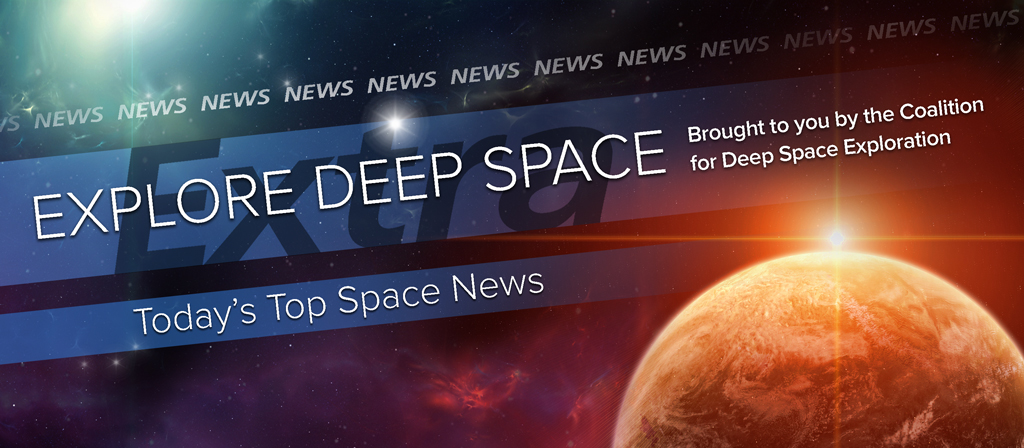In Today’s Deep Space Extra… Budget stability is essential for the successful development of NASA’s frontier opening Space Launch System rocket.
Human Deep Space Exploration
Upon closer look, NASA’s exploration systems are game-changers
Space News (2/22): NASA’s Space Launch System brings a powerful and flexible asset to future U.S. space exploration, including human activities in cis-lunar space and the Martian realm as well as accelerated transits for planetary science missions to distant but intriguing destinations like Europa, according to Mary Lynne Dittmar, executive director of the Coalition for Deep Space Exploration. The path to success for SLS development, now on schedule for its first uncrewed test flight in 2018, requires budget stability, she writes in an op-ed.
SLS upper stage caught in political tug-of-war
Space News (2/19): The U.S. White House and Congress appear at odds over the schedule and funding to human rate the first upper stage designated for NASA’s Space Launch System exploration rocket. At the request of Congress, NASA will stop efforts to human rate the Interim Cryogenic Propulsion Stage for Exploration Mission-2, the first planned crewed launch of the Orion crew capsule and SLS between 2021 and 2023. An uncrewed version of the Orion atop SLS with the ICPS is scheduled to launch in late 2018 on Exploration Mission 1. NASA is funded in 2016 to pursue development of a more powerful upper stage, the Exploration Upper Stage.
NASA just smashed its record for astronaut applications18,000+
Ars Technica (2/19): A record number of U.S. citizens would like to train as NASA astronauts, a little more than 18,300, the space agency announced on Friday, hours after a midnight application deadline for 2017 hires passed. The agency will spend another 18 months evaluating the hopefuls before naming an estimated 8 to 14 new astronauts. New astronauts will train for missions to the International Space Station and early missions of Orion capsules launched on the Space Launch System exploration rocket into cis-lunar space.
To make a moon village, think beyond science and engineering (op-ed)
Space.com (2/19): “It is time to take a more transparent, integrative and interdisciplinary approach to space exploration,” writes Brown University senior Tomoya Mori, a student of exploration, media and education. “Settling on a celestial body is far different from simply going there,” according to Mori. “To establish a sustainable living space in such a hostile environment, one needs to not only think about science and engineering, but also consider psychological, architectural, societal, political and economic aspects.”
Space Science
Report suggests NASA fly precursor to Asteroid Redirect Mission
Space News (2/19): NASA’s proposed Asteroid Redirect Mission, a robotic mission to gather a large boulder from the surface of a Near Earth Asteroid and place it in orbit around the moon, might benefit from a precursor mission, according to a study by an agency Formulation Assessment and Assessment Team. Once in orbit around the moon, a boulder several meters across would become a destination for astronauts launched aboard an Orion capsule atop a Space Launch System exploration rocket in the 2020s.
ExoMars orbiter and lander mated for final time
Spaceflightnow.com (2/19): ExoMars, a joint European/Russian mission that includes an orbiter and lander, is being prepared for a March 14 lift off from the Baikonur Cosmodrome in Kazakhstan. The spacecraft should reach Mars in October. A second ExoMars mission, with a rover, is planned for a 2018 or 2020 launching.
Rings may be common around a weird kind of asteroid
Discovery.com (2/19): Asteroid Chariklo orbits the sun between Saturn and Uranus. Discovered in 2014, Chariklo’s unusual nature includes a ring system. Chariklo’s Kuiper Belt origins may explain the rings.
Low Earth Orbit
HoloLens in space: NASA astronaut Scott Kelly dons Microsoft’s holographic headset
Geek Wire (2/20): Aboard the International Space Station, astronauts are evaluating Microsoft’s Hololens, eye ware that could enable flight controllers to assist faraway space explorers faced with complex tasks.
Roscosmos plans to return military specialists to Cosmonaut Training Center – Komarov
Interfax, of Russia (2/21): Russia’s military will once again have a role in the training of Russian cosmonauts, the chief of Russia’s state space corporation, Roscosmos, announced on Friday. However, the country’s defense ministry will not be in charge, according to the report.
Commercial to Low Earth Orbit
Air Force will move off Russian engines, general says
Air Force Times (2/20): The U.S. should have a domestic alternative to imports of Russia’s RD-180 rocket engine between 2022 and 2023, according to Lt. Gen. Samuel Greaves, the commander of the Air Force Space and Missile Systems Center. Until then, imports of the RD-180 for the United Launch Alliance Atlas V will be necessary for the launching of U.S. national security missions, he said.
Suborbital
Virgin Galactic unveils second SpaceShipTwo
Space News (2/19): Virgin Galactic founder Richard Branson unveiled the suborbital passenger space plane SpaceShipTwo on Friday at the company’s Final Assembly, Integration and Test Hangar in Mojave, Calif. The ceremony transpired 16 months after SpaceShipOne crashed during a test flight that claimed the life of one pilot and injured the second.
How has Virgin Galactic made their latest spaceship safer?
Christian Science Monitor (2/20): Virgin Galactic pursues greater safety as it prepares Space Ship Unity for test flights ahead of passenger launches into suborbital space. Physicist Stephen Hawking is among the more than 700 who plan to launch.
Major Space Related Activities for the Week
Major space related activities for the week of February 22-26, 2016
Spacepolicyonline.com (2/21): Congress returns to Washington this week for hearings on the administration’s proposed 2017 budget and other matters. The U.S. House Science, Space and Technology Committee hosts a hearing Thursday on the Space Leadership Preservation Act, which would change the way NASA is led.

